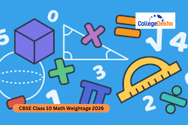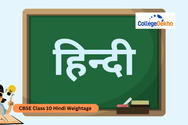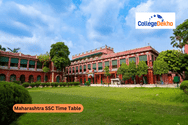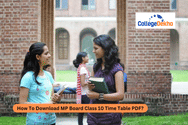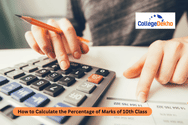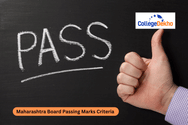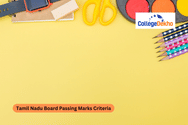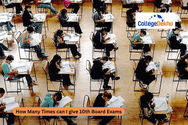MP Board 10th Exam Pattern 2025-26 helps you to check the detailed curriculum so that you can easily start studying for the exam. Mostly, the theory papers will be conducted for 75 marks in MP class 10.
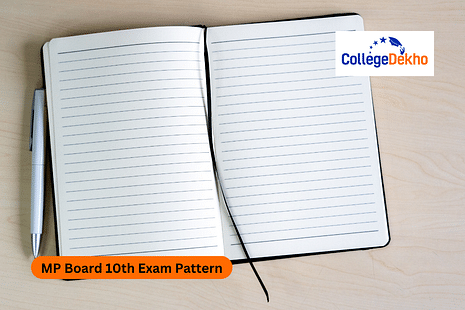

Never Miss an Exam Update
About MP Board 10th Exam Pattern 2025-26
The curriculum for class 10th MP includes six major subjects. Three language papers are followed by three compulsory papers for Mathematics, Science, and Social Science. The language subjects include Hindi, English, Sanskrit, Marathi, Urdu, Bengali, Gujarati, Telugu, Tamil, Punjabi, Sindhi, Malayalam, Kannada, and Oriya. The theory paper for all subjects will be conducted for 75 marks, and the remaining marks will be provided for internal assessment. The duration for the theory paper will be 3 hours, and the internal evaluation will be two hours. You need to secure 33% marks combined in both theory and practical exams to pass. You must have detailed information about the MP Board 10th Syllabus 2025-26 to prepare effectively for the exam. For the convenience of the students, a PDF file regarding the practical exams and internal assessment is also available online.
The question paper will be a blend of MCQs, very short answer type questions, short answer type questions, and long answer type questions. For language papers, the reading, writing, and grammar skills of the students will be tested. Read more about the MP Board 10th Exam Pattern 2025 here:
Also Read: MP Board 10th Model Paper 2025-26
MP Board Latest Updates
- Aug 14, 2025 - MP Board 10th Time Table 2025 has been released by the board and the exams are to be held from Feb 11 to March 2, 2026.
MP Board 10th Blueprint 2025-26
Check out some of the important highlights regarding the exam pattern from the pointers given below:
- Around 5 major subjects are included in the Class 10 curriculum for the MP Board.
- Each theory paper will be conducted for 75 marks, and 25 marks will be allotted for the practical exam.
- You can refer to the subject-wise marking scheme from the table given below:
Subjects | Total Marks | Practical Marks |
|---|---|---|
Sanskrit | 75 | 25 |
Urdu | 75 | 25 |
Punjabi | 75 | 25 |
Gujarati | 75 | 25 |
Sindhi | 75 | 25 |
Social Science | 75 | 25 |
Painting | 75 | 25 |
Indian Music | 25 | 75 |
Computer Science | 75 | 25 |
Hindi | 75 | 25 |
English | 75 | 25 |
Marathi | 75 | 25 |
Mathematics | 75 | 25 |
Science | 75 | 25 |
MP Board 10th Exam Pattern 2025-26 Subject Wise
5 main subjects are included in the curriculum according to the MP 10th Exam Pattern 2025. One language subject can be chosen as English, and the other subject can be chosen according to the regional language in which the student is comfortable. Other subjects included in the curriculum are Mathematics, Social Science, Science, and Computers. You can refer to the subject-wise exam pattern from the table given below:
English
The theory paper in English will be conducted for 75 marks, and the practical exam will be conducted for 25 marks. You can refer to the MP Board Class 10 English Exam Pattern 2025-26 from the table given below:
Section | Marks Weightage |
|---|---|
Section - A: Reading (10 Marks) | |
Unseen Passage | 5 Marks |
Unseen Passage | 5 Marks |
Section - B: Writing ( 16 Marks ) | |
Note-Making | 4 Marks |
Letter Writing | 4 Marks |
Long Composition | 5 Marks |
Picture Guided Composition | 3 Marks |
Section - C: Grammar (10 Marks) | |
Fill in the Blanks | 5 Marks |
Do as directed | 5 Marks |
Section - D: Textbooks ( 39 Marks) | |
Total Marks: 75 Marks | |
Hindi
The theory paper in Hindi will also be conducted for 75 marks. You can refer to the detailed information about the MP Board Class 10 Hindi Exam Pattern 2025-26 here:
Units | Marks |
|---|---|
Kshitij Part 2 Kavya Khand | 17 |
Kavya Bodh | 10 |
Kshitij Part 2 Prose | 17 |
Language comprehension | 8 |
Kritika Part 2 | 8 |
Unseen passages | 4 |
Letter writing | 4 |
| 7 |
Total | 75 |
Mathematics
The total marks allotted for the theory exam in mathematics are 75 marks. You can check out the detailed information about the MP Board Class 10 Math Exam Pattern 2025-26 from the table given below:
S.no | Units/Chapters | Marks |
|---|---|---|
1 | Chapter 1- Rational Numbers Introduction, Fundamental Theorem of Arithmetic, Recirculation of Irrational Numbers, Summary | 6 |
2 | Chapter 2 Polynomials Introduction, the geometric meaning of zeroes of a polynomial, relationship between zeroes and coefficients of a polynomial, summary. | 5 |
3 | Chapter 3 Pair of Linear Equations in Two Variables Introduction, Solution of a pair of linear equations by graphical method. Algebra method of solving a pair of linear equations (substitution method, elimination method), Summary | 7 |
4 | Chapter 4 Quadratic Equations Introduction, Quadratic Equations, Solution of Quadratic Equations by Factors, Nature of Roots, Summary | 5 |
5 | Chapter 5- Arithmetic series introduction, Arithmetic series. A.P, A.P Sum, Summary | 5 |
6 | Chapter 6- Triangle Role, Similar Figures, Similarity of Triangles, Similarity of Triangles, Criteria for similarity of triangles, Summary | 5 |
7 | Chapter 7- Coordinate Geometry Introduction, Distance Formula, Division Formula, Summary | 5 |
8 | Chapter 8 - Introduction to Trigonometry, Introduction, Trigonometric Ratios, Some Specific Angles, Trigonometric Ratios, Trigonometric Identities, Summary | 5 |
9 | Chapter 9- Some Applications of Trigonometry Heights and Distances, Summary | 5 |
10 | Chapter 10- Circle Role, Tangent to a circle, Number of tangents from a point to a circle, Summary | 5 |
11 | Chapter 11- Areas related to circles, Areas of sectors and sectors, summary | 5 |
12 | Chapter 12- Surface area and volume, volume of combination, Solids introduction, surface area of combination of solids, Summary | 6 |
13 | Chapter 13- Statistics Introduction, Mean of grouped data, Mode of grouped data, Median of grouped data, Summary | 5 |
14 | Chapter 14- Probability: A Theoretical Approach, Summary | 6 |
Science
The theory paper in Science will be conducted for a total of 75 marks. You can check out the detailed information about the MP Board Class 10 Science Exam Pattern 2025-26 from the table given below:
Chapters | Weightage |
|---|---|
Chemical reaction, Chemical equilibrium, and chemical compounds. | 6 |
Light | 7 |
Electricity | 8 |
Sources Of Energy | 5 |
Life processes, Digestion & respiration | 6 |
Transportation, Excretion | 8 |
Reproduction, growth, Heredity, and Evolution | 5 |
Metals & Non-metals | 9 |
Carbon | 8 |
Environment and environmental problems – Classification of medicinal plants | 8 |
The Universe – Broad | 5 |
Total | 75 |
Social Science
You can refer to the MP Board Class 10 Social Science Exam Pattern 2025-26 from the table given below:
Chapter Name | Marks |
|---|---|
Contemporary India 2 | |
Resources and Development | 4 |
Forest and Wildlife Resources | 4 |
Water Resources | 1 |
Agriculture | 3 |
Mineral and Energy Resources | 4 |
Manufacturing Industry | 4 |
Lifelines of the National Economy | 7 |
India and the Contemporary World 2 | |
Rise of Nationalism in Europe | 2 |
Nationalism in India | 7 |
The making of a globalized world | 3 |
Era of Industrialization | 4 |
Printing Culture and the Modern World | 4 |
Democratic Politics-2 | |
Power Sharing | 2 |
Federalism | 4 |
Caste, Religion, and Gender Issues | 2 |
Political Parties | 4 |
Results of Democracy | 3 |
Understanding of Economic Development | |
Development | 2 |
Sectors of the Indian Economy | 4 |
Money and Credit | 4 |
Globalization and Indian Economy | 3 |
Consumer Rights | - |
Total | 75 |
Computer
The theory paper in Computer Science will also be conducted for a total of 75 marks, and 25 marks will be allotted for the practical exam. Check out the exam pattern from the table given below:
Units | Marks |
|---|---|
Networking | 30 |
HTML | 30 |
Cyber Ethics | 15 |
Total | 75 |
How To Download MP Board 10th Exam Pattern 2025-26?
Now that the MP Board 10th Exam Pattern 2025-26 has been released on the official website of the Madhya Pradesh Board of Secondary Education, students must download it to prepare for the exam:
- Step 1: Go to the official website of the Madhya Pradesh Board of Secondary Education at mpbse.nic.in
- Step 2: A dialogue box with the latest notification will open on your screen. Click on शैक्षणिक सत्र 2025-26 के लिए कक्षा 9वीं से 12वीं तक समस्त विषयों की अंकयोजना ।
- Step 3: The PDF of the marking scheme will open on your screen for the different subjects included in the curriculum for classes 9th to 12th.
You must download the latest MP Board 10th Exam Pattern 2025-26 as available on the official website of the Madhya Pradesh Board of Secondary Education. Make sure to refer to the latest curriculum when planning out the study session, focusing on every aspect equally to gain good marks in the result.
Are you feeling lost and unsure about what career path to take after completing 12th standard?
Say goodbye to confusion and hello to a bright future!

FAQs
Madhya Pradesh Board of Secondary Education will release the official PDF of the latest MP Board 10th Exam Pattern 2025-26 on their website at mpbse.nic.in. Students must prepare for the exam only based on the latest exam pattern; however, no new changes are recorded in the curriculum. Along with the marking scheme, students can also download the syllabus PDF and the PDF for the syllabus of the practical exam and internal assessment to be conducted for class 10th students. All the PDF files are now available online.
According to the MP Board 10th Exam Pattern 2025-26, theory exams will be conducted for 75 marks and 25 marks will be allotted for the practical session. Students are required to get 33% marks combined in both exams to be eligible for the passing certificate.
To download the MP Board 10th Exam Pattern 2025-26, students need to first visit the official website of the Madhya Pradesh Board of Secondary Education at mpbse.nic.in and then click on the option called शैक्षणिक सत्र 2025-26 के लिए कक्षा 9वीं से 12वीं तक समस्त विषयों की अंकयोजना ।
No new changes are recorded in the MP Board 10th Exam Pattern 2025-26 however students must still refer to the latest curriculum when making a study plan for the rest of the academic year.
According to the MP Board 10th Exam Pattern 2025-26, MCQs, very short answer type questions, short answer type questions, and long answer type questions will be included in the question papers.
Was this article helpful?








